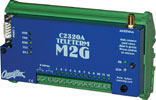
The ability to monitor environmental conditions easily and reliably is important in many areas of the pharmaceutical industry. From the moment raw materials are received to final product delivery, it is crucial to ensure that factors such as temperature and humidity remain within acceptable limits. In the case of an out-of tolerance event, it is essential to be able to quickly pinpoint the location and time of violation in order to address the problem and get back on track. It is also necessary to be able to provide industry, government and regulators with the data they require in the event of an audit.
Today’s data-loggers are small, low cost, rugged devices that can take secure, unattended measurements at user-specified intervals 24 hours a day, seven days a week. They monitor a wide range of environmental parameters (eg, temperature, relative humidity, light), and are powerful tools for use in storage, shipping, manufacturing, research and facilities management applications. They do not require supervision and eliminate the human effort and error associated with manual monitoring operations.
This article gives an overview of how data-loggers can be applied in the pharmaceutical industry, and provides advice on important factors to consider when evaluating different data-loggers for an application.

The pharmaceutical industry – how data-loggers fit in
Generally, data-loggers are small devices that can be installed quickly into the environment to be monitored; they are unobtrusive in laboratories, or the process environment. The most advanced loggers can be configured to record data at any interval the user chooses, and are supported by user-friendly software that makes deployment and data downloading and analysis simple.
Data-loggers can be deployed for many applications, from the receipt and storage of raw materials to customer delivery. For example:
* Storage of product and raw materials – loggers can be deployed around a warehouse or in refrigeration units to monitor humidity, temperature, and light levels.
* Manufacture of products – loggers might be assigned to individual pieces of equipment to record power use, or can be deployed in work areas to monitor carbon monoxide, temperature and humidity.
* Research laboratories – loggers fit easily in incubators, refrigerators, hoods, and in general lab spaces and can constantly monitor and verify temperature, gases, humidity, etc.
* In-depth assessment – an array of loggers can easily be deployed in a manufacturing plant or at points around an office building to troubleshoot problems or assess energy efficiency.
Ease of configurability and installation
All data-loggers require setup and configuration, but some require more from than others. User-friendly loggers can be set up by someone with no training in electrical wiring or programming. The user just removes the SD card from the logger and plugs it into a PC with reader. The data can simply be read into a spreadsheet and processed.
Remote applications can be connected via networks to a data centre, automatic reports from consolidated and aggregated data can be sent via em-ail to recipients. All data can be stored and accessed via the Internet and browsed or downloaded as required.
Data download options
Consider the time to be allotted to downloading data. In the most straightforward systems, data download is achieved by connecting the logger via a cable to a laptop or desktop computer equipped with the appropriate software. A removable SD card is far quicker and can be collected and taken back to an office for analysis.
Alternatively, data can be sent to a web-based data centre automatically from multiple loggers at many different locations and data aggregated and processed automatically for the auditors or monitoring bodies.
Cost of ownership
The cost of monitoring manually is high in people equipment and time and is unreliable due to the human factor; an automated system does not sleep and is active 24/7/365. A simple monthly bill in the same scale as a cellphone is all that is required.
Flexibility and expandability
Simple standalone data-loggers are suitable for most pharmaceutical monitoring applications. However, there may be situations where more data gathering capacity for multiple parameters is required.
For example, to carry out a complete environmental analysis or verification of a facility’s storage facilities, it may be necessary to measure temperature, humidity and light intensity at several points at different locations. Users then need to be able to configure a system with a variety of sensors.
Conclusion
Data-loggers are the ideal tools for monitoring environmental conditions throughout the pharmaceutical industry, from manufacture and storage to research and development. The affordable, reliable units collect data when and where it is needed and cut out the time wasting associated with configuring devices or formatting data.
For more information contact Ian Loudon, Omniflex, +27 (0)31 207 7466, ianl@omniflex.com, www.omniflex.com
| Tel: | +27 31 207 7466 |
| Fax: | +27 31 208 2058 |
| Email: | sales@omniflex.com |
| www: | www.omniflex.com |
| Articles: | More information and articles about Omniflex Remote Monitoring Specialists |
© Technews Publishing (Pty) Ltd | All Rights Reserved